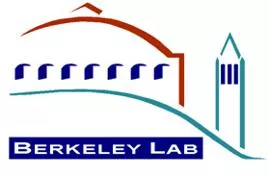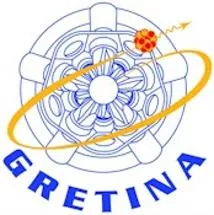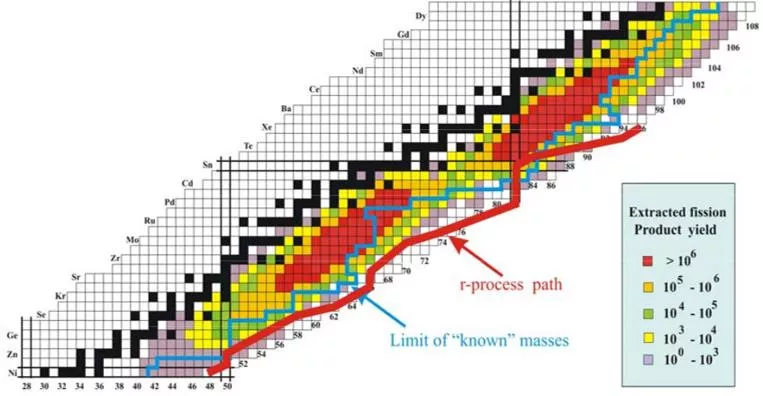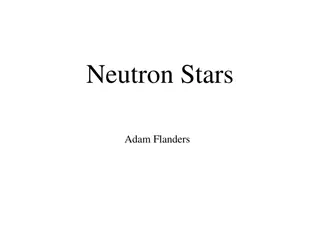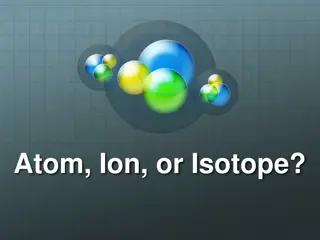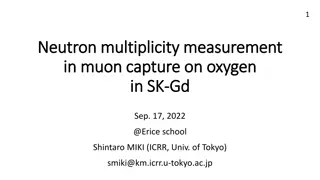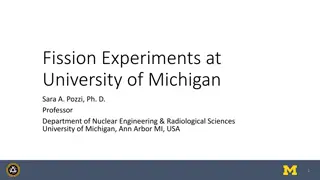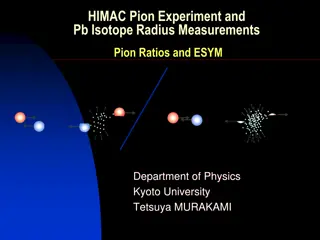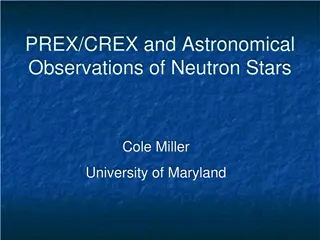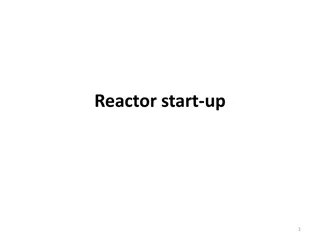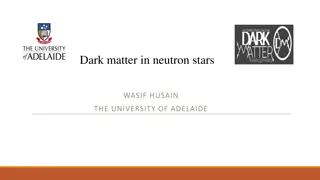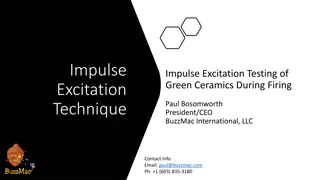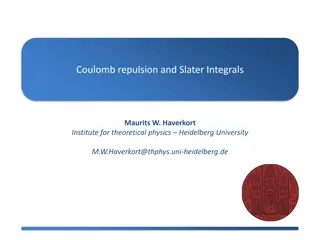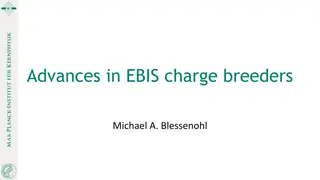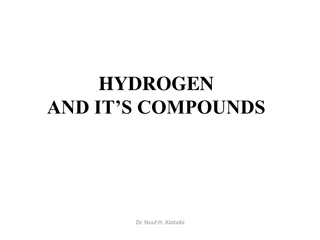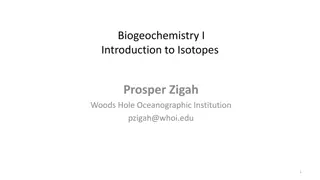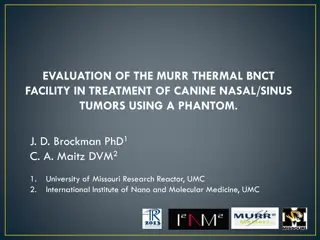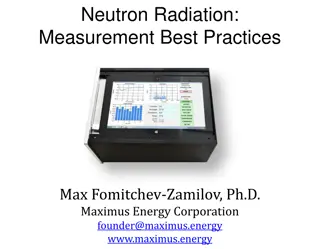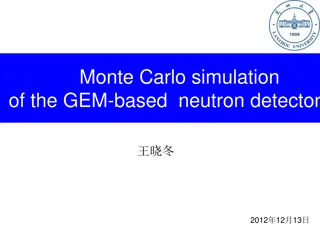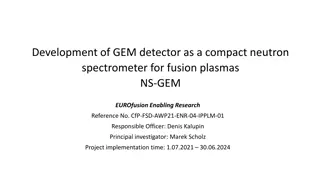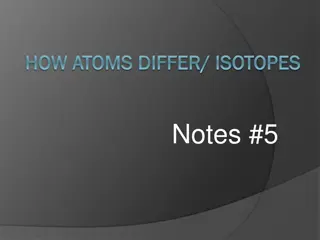Coulomb Excitation Studies of Neutron-Rich Ru and Mo Isotopes
Workshop presentation on using GRETINA, CHICO, and CARIBU for Coulomb excitation studies of even Ru and Mo isotopes, exploring shape evolution through systematic studies and experimental limitations like beam intensity and purity. Analysis includes gamma intensities, level schemes, and nuclear reorientation effects.
Download Presentation

Please find below an Image/Link to download the presentation.
The content on the website is provided AS IS for your information and personal use only. It may not be sold, licensed, or shared on other websites without obtaining consent from the author.If you encounter any issues during the download, it is possible that the publisher has removed the file from their server.
You are allowed to download the files provided on this website for personal or commercial use, subject to the condition that they are used lawfully. All files are the property of their respective owners.
The content on the website is provided AS IS for your information and personal use only. It may not be sold, licensed, or shared on other websites without obtaining consent from the author.
E N D
Presentation Transcript
Coulomb excitation of even 108-112Ru and 104-108Mo isotopes Juho Rissanen Nuclear Structure Group, Lawrence Berkeley National Laboratory March 1, 2013 GRETINA workshop 2013 1
COULEX with GRETINA and CHICO2 Highest CARIBU yields at Z 42,N 64 in the lower mass region (106Mo) Reaccelerated beams of refractory elements low E(2+) -> high B(E2) -> high Coulomb excitation cross-section Multiple Coulex of Ru/Mo isotopes on heavy target at safe energies December 2012 GRETINA CHICO2 Good Doppler correction -> better energy resolution March 1, 2013 GRETINA workshop 2013 2
Physics motivation, nuclear shapes r-process path Variety of different shapes Ru Mo prolate oblate triaxial 82 Faisal et al., PRC 82, 014321 (2010) 112Ru Ru isotopes Shape evolution vs mass? 50 Shape evolution vs spin? =0.6 MeV =0 =0.2 MeV =0.4 MeV N=64 N=66 N=68 N=70 March 1, 2013 GRETINA workshop 2013 3
Shape coexistence in Kr isotopes Coulomb excitation of 74,76Kr beams with 208Pb target at GANIL at safe energies High-statistics data allows determination of deformation parameters Q and cos(3 ) for different states c.m. gamma beta 74Kr, 150 hours, 1E4 beam intensity, 99% pure Clement, PRC 75, 054313 (2007) March 1, 2013 GRETINA workshop 2013 4
Summary GRETINA+CHICO+CARIBU allows Coulomb excitation studies of neutron-rich Ru and Mo isotopes Systematic studies of the shape evolution vs. I,Z in the A=110 region (prolate, oblate, shape coexistence, triaxiality) What are the experimental limitations? Beam intensity? With December 2012 performance, 104,106Mo possible in 12 days of beam time. 3 x increase allows 108Mo also Beam purity? How well the impurities are known? Beam energy, E? Thanks for your attention March 1, 2013 GRETINA workshop 2013 5
Backup slides March 1, 2013 GRETINA workshop 2013 6
Analysis Gamma intensities ->CE cross-section Mo and Ru isotopes, level schemes known, some level lifetimes known -> input everything to GOSIA code vary parameters -> try to extract diagonal matrix elements -> static quadrupole moment Q0 for a given state Rather complete set of matrix elements needed Mf If d /d =f[B(E2),Q], 2ndorder Ii Nuclear reorientation effect March 1, 2013 GRETINA workshop 2013 7
Some mathematics Measurable matrix elements < ??| ?2 ?20|??>= ( 1)2?? 2??+1 ?< ??| ?(?2) |??>< ??| ?(?2) |??> < ?| ?2 ?20|? >=?2 2 ?? 2 ?? 0 ?? 5 2 35?3cos(3 ) < ?| ?2 ?22 ?20|? >= Q is a quadrupole deformation parameter (Bohr s ) cos (3 ) is a triaxiality parameter (Bohr s ) March 1, 2013 GRETINA workshop 2013 8
Experiment 106Mo: B(E2)=1.31 74Kr: B(E2)=0.84 -> (106Mo) (74Kr) x 1.6 Is the mass resolution good enough? mass106_ions mass resolution 10000 Zr Nb Mo Tc Ru 1e+04 ~1 mg/cm2 thick 208Pb target 1e+02 factor of 2 down in gamma efficiency Yield (1/ s) 1e+00 More intense beam appreciated to measure several cases / beam time 1e 02 40 50 60 70 80 90 100 110 Mass (MeV) Good gamma energy/position resolution needed to tolerate beam impurities 10 000 counts in photopeak needed March 1, 2013 GRETINA workshop 2013 9
Beam time days Factor of 2 down in gamma efficiency 10000 counts in a photopeak Isotope CEvs Kr Beam vs Kr Beam time days 108Ru 1.2 1.3 1.4 1.1 1.6 1.6 1.9 0.8 1.5 0.4 0.2 1.2 1.4 0.2 12.5 6.7 26 57 6.5 5.7 35 110Ru 112Ru 102Mo 104Mo 106Mo 108Mo March 1, 2013 GRETINA workshop 2013 10
Other examples Cline Ann. Rev. Nucl. Part. Sci. 36, 683 (1986) Q, cos 3 vs mass Q, cos 3 vs spin band g.s. band 0+2band 0+3band March 1, 2013 GRETINA workshop 2013 11






